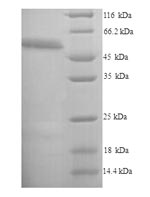Intact mouse receptor-interacting serine/threonine-protein kinase 3(Ripk3) cDNA (1-486aa) with an N-terminal 6xHis-tag was expressed in the yeast. The forming protein is the recombinant full-length Human Ripk3 protein. The purity of this protein is greater than 90% determined by SDS-PAGE. Under reducing conditions, the SDS-PAGE showed a molecular weight band of about 56 kDa. The slightly higher molecular mass is attributed to glycosylation. Apart from generating anti-Ripk3 antibodies, this recombinant Ripk3 protein may find uses in the studies of necroptosis-activated pathologies.
Ripk3 is a key regulator of necroptosis, apoptosis, and inflammatory signaling. Ripk3 interacting with RIPK1 through RIP homotypic interaction motif (RHIM) forms a necrosome, facilitating the activation of MLKL that executes necroptosis by promoting plasma membrane permeabilization and cell rupture. It can also modulate apoptosis by activating the caspase-8-RIPK1 complex under certain conditions. Previous studies reported that Ropk3 can promote aerobic metabolism through phosphorylation of several metabolic enzymes. Xiaoru Duan etc. proposed that suppression of RIPK1/RIPK3/MLKL-mediated keratinocyte necroptosis protected against psoriatic inflammation.




